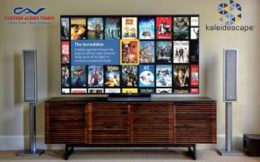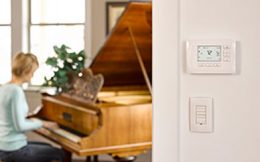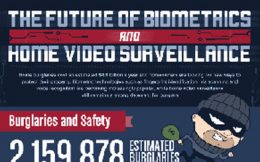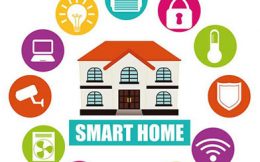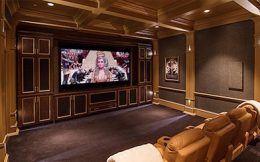The Evolution of Television Delivery
 1950: 9 percent of U.S. households enjoyed TV using over the air antennas. As the name suggests, OTA delivered content through the air using radio frequency (RF) signals which were received by antennas placed on top of their televisions. Using the antennas on the television, viewers would literally pull the signal out of the air. However, an antenna could only transmit a signal so far, and if you were not within that range, you could not get the signal.
1950: 9 percent of U.S. households enjoyed TV using over the air antennas. As the name suggests, OTA delivered content through the air using radio frequency (RF) signals which were received by antennas placed on top of their televisions. Using the antennas on the television, viewers would literally pull the signal out of the air. However, an antenna could only transmit a signal so far, and if you were not within that range, you could not get the signal.
1960: 87 percent of households now owned a TV thanks to the rise of community antenna television (CAT) better known as cable television. This system used the same RF signals but delivered the video content to individual homes using coaxial cable. Large “community antennas” were erected near communities that could not receive OTA signals due to distance or challenging/mountainous terrain, and coaxial cable was run from the community antenna to individual homes.
1972: Canada provides the first commercial North American satellite to carry television transmission. Analog Satellite TV is born. With the purchase of a satellite service, consumers were then given access to television programming via an outdoor parabolic antenna usually referred to as a satellite dish. However, much like CAT, analog satellite TV was limited to the number of channels provided by the frequency spectrum.
1990: Digital cable television and digital satellite television came upon the scene allowing both broadcasters and cable companies the ability to “shrink” the video signal needed for one channel. By doing so, multiple television channels were now able to “fit” within one analog channel frequency space. Hence, more channels.
2007: Netflix begins to blue the barrier between computer and television with the launching of a “Watch Instantly” streaming service. No longer do individuals have to wait for their D.V.D.’s to arrive by mail. Rather, they can log onto their computers and utilize the service instantly. Shortly thereafter, Apple launches Apple TV. Consumers are magically granted the ability to “watch” internet television within the comfort of their living room.
2008 and on: Hulu, Amazon Instant Video HBO Go, SHOWTIME ANYTIME, and Sling TV among others offer streaming services to consumers. As consumers are given a plethora of streaming services to choose from, digital cable television and digital satellite television are becoming a thing of the past.
….So, what’s next?
Now that we have Smart TV’s (televisions with built in streaming capabilities) as well as add-on components that we can buy (such as Apple TV and Roku), where do we go from here?
Major networks and movie studios are going to be huge game-changers. They know that they are going to have to step up their game if they want to keep the consumers interested. Already, CBS has launched an “All Access” streaming service and the other networks aren’t following far behind them. Disney has publicly shared plans to pull their content from Netflix soon, in fact, and begin their own streaming service in 2019. Other movie studios will follow suit.
Simply put, gone will be the days that you will have to purchase a pre-set package of channels just to get the few you really wanted. Instead, the future will be a la carte: you will be able to pick and choose the channels that you really want. Not only that, you will be able to watch them on your own schedule.
Do Your Part and Go Green with Home Automation
 Have you noticed that every winter, it gets a little warmer with a little less snow? What about the summer months? Have you noticed that every summer…it gets a little bit hotter and lasts a tiny bit longer than the last? No one can disagree, through the decades, we have noticed it. For many decades, the climate changes were inconspicuous. For a while there, we could deny it and claim that global warming was just something fictitious. However, now though, we have no choice but to face the truth…it turns out that global warming is something that actually exists and we’re starting to realize that it’s definitely going to impact us!
Have you noticed that every winter, it gets a little warmer with a little less snow? What about the summer months? Have you noticed that every summer…it gets a little bit hotter and lasts a tiny bit longer than the last? No one can disagree, through the decades, we have noticed it. For many decades, the climate changes were inconspicuous. For a while there, we could deny it and claim that global warming was just something fictitious. However, now though, we have no choice but to face the truth…it turns out that global warming is something that actually exists and we’re starting to realize that it’s definitely going to impact us!
Global Warming is “an increase in the earth’s atmospheric and oceanic temperatures widely predicted to occur due to the greenhouse effect.” (Greenhouse effect: when the Earth’s atmosphere becomes thick with gases, such as carbon dioxide, and other substances resulting from pollution) yourdictionary.com & merriam-webster.com
Because of our actions on Earth, predominately over the last 50 years, we are now finding ourselves in quite a pickle! What’s worse, if we keep living the way that we have been, rather than us, our future generations will be the ones left to pick up the pieces. The fact of the matter is…our environment is everyone’s responsibility. So, until they figure out an alternate planet for our children’s children to live on, we all have to do our part to try to slow this monster down.
“What does a home automation system have to do with me doing my part?”
Because energy consumption plays a major role in global warming, it only makes sense that we should all find new ways to use energy. Smart home technology reduces your overall energy consumption, so if someone is interested in truly impacting the environment in a positive way, having a home automation system is a viable way to make a difference. Home automation systems now allow clients the opportunity to erase their carbon imprint (a negative imprint or effect, left by a human that once walked upon the earth), the system will also save people money and add convenience to any home, business or office. It’s now simpler than ever to automate your home and go green at the same time without even trying. Sure, recycling and planting trees helps, but automating your home is a surefire way to EASILY do the right thing, go green and call it a day.
“What can I automate in my home to reduce my energy consumption?”
There are countless, uncomplicated ways you can automate. For instance, did you know that lighting accounts for almost 20% of the average homeowner’s monthly bill? One way that you can “go green” is by integrating energy efficient lighting and energy-saving smart lighting controls in your home. With the use of automatic timers, motion and occupancy sensors (occupancy sensors can cut lighting costs by as much as 50%), you will be able to reduce your energy usage by simply controlling the lights to automatically turn off when no one needs them. Also, you can have automated light dimmers installed, and this will help to conserve energy as well. Therefore, automating your light system is a great way to reduce your energy consumption. Custom Audio Video would love to help you save money on your energy consumption bill each month.
Custom Audio Video can help you conserve energy with your heating and cooling consumption. For instance, one way that you can automate your home to reduce energy is through the use of a programmable thermostat. Since nearly half of a typical energy consumption bill goes towards heating and cooling, a programmable thermostat offers both the flexibility and power to control the climate in your home efficiently while saving energy and lowering your energy bill in the process. With a touch of a button, you can adjust your heating and cooling system any time of day—even while you’re away from home. You can also pre-program the thermostat, for example, to reach a certain temperature each day only for a particular span of time.
Utilizing nature’s daylight will also reduce your need for electric light, and therefore, limits your energy consumption. You can choose to have window shades installed and automated, programmed to open and close at particular times throughout the day. This will help optimize daylight in your home, reduce heating and cooling costs, and add stylish comfort to any rooms’ décor.
With Custom Audio Video’s home automation system in your home, you can finally feel confident that you are doing your part…helping to save the world…one imprint at a time.
Call today to learn more about Custom Audio Video’s new “Go-Green” Package & Add-ons
A Smarter Sense of Security
 How smart is your home? According to the FBI, 65 percent of home burglaries occur between 6 a.m. and 6 p.m. while most consumers are not at home. However, with the use of smart home technology, criminal activity can be deterred before it even occurs. Rather than leaving it up to fate, smart home consumers have taken back the control, and they now possess the tools to outsmart criminals.
How smart is your home? According to the FBI, 65 percent of home burglaries occur between 6 a.m. and 6 p.m. while most consumers are not at home. However, with the use of smart home technology, criminal activity can be deterred before it even occurs. Rather than leaving it up to fate, smart home consumers have taken back the control, and they now possess the tools to outsmart criminals.
Did you know that, most of the time, burglars report entering a home through an unlocked door? With a smart home system, users can remotely verify that all of the doors are locked and arm their security system if they forgot to do so when they left. With smart home technology, you can play an active role in controlling your home environment…even when you are not there.
Control from a Distance
With Custom Audio’s Smart Home Technology, users can remotely control their indoor and outdoor lights, lock and unlock doors, arm and disarm their security system all from a distance using their smartphone, tablet or web-enabled device. Through our integrated video and audio technology, homeowners cannot only see and hear what is taking place in real time, they can also play an active role as if they are physically there. Similar to our two-way voice support system, a microphone and speaker interface can be installed near the front door. A homeowner will then have the ability to converse with whomever comes to the door.
Let’s say that a homeowner has a dog-walker that’s come to the house to walk their dog. The dog-walker can ring the bell, which then sends a message to the homeowner’s phone. The homeowner then has the capability to converse with the dog-walker and unlock the door for them. Once the video or motion sensors have ensured that the dog walker has left for the day, the door can be re-locked. Simple as that.
Monitoring school-age children when there is no adult supervision has always been a safety concern for parents. Smart home technology may be more expensive than a babysitter, but when it comes to the safety and comfort of your children, any price is worth paying. For example, let’s say you have a school-age child, and he/she gets off the bus each day at 3:45 p.m. From a distance, if you have the smart home technology, you will be able to verify that he/she has gotten into the house safely, had a snack, what they were watching on television, if they’ve had visitors and whether they’ve stayed put in the house or not while you’ve been gone.
Are you an avid online shopper? The average U.S. homeowner receives an average of 27 packages each year, which creates a real worry that packages left on the doorstep will be stolen. Since the majority of packages are left midday, allowing your package to be left at your doorstep is sort of like playing Russian-roulette. With smart home technology, you can verbally communicate with the deliverer and even unlock the door for her/him temporarily if you want to.
Regardless of your lifestyle, let Custom Audio Video help you take back the control.
The Future Of Biometrics And Home Video Surveillance
Home burglaries cost an estimated $4.6 billion a year and homeowners are looking for new ways to protect their property. Biometric technologies such as fingerprint identification, iris scanning, and voice recognition are becoming increasingly popular, while home video surveillance still remains a strong deterrent for burglars. All of them are constantly being improved and may soon be integrated for a truly smart home security system. To learn more, checkout the infographic below created by Custom Audio Video, the custom home theater experts.
Burglaries and Safety
Crime is rampant across the country and even homes can no longer be considered safe. The numbers don’t lie. Statistics show that there were over 2 million estimated burglaries in 2010 according to the FBI. That’s a lot of incidents for just a single year with tens of thousands committed every single day. The total losses in property come in at roughly $4.6 billion – a large sum however you look at it. People are losing a great deal of money because of these incidents. The majority of the cases involve forcible entry while property crimes comprise 23.8%.
Some security systems use passwords for an added layer of protection. Only the user is supposed to know the password, which allows them entry into the premises. However, studies show that 3 out of 4 consumers use duplicate passwords. These are unsafe and easily cracked by trained hackers. What makes them doubly vulnerable is that these passwords have not been changed in 5 years or more. This gives malicious individuals ample time to crack the code and push through with their plans. Experts always recommend that people regularly change their passwords and avoid recycling old ones. Using a combination of upper case and lower case letters, as well as number and special characters, also bolsters the strength of the security.
Biometrics
There are other ways to prevent unauthorized access to property. Biometrics, for instance, is emerging as one of the most promising fields in the security industry. This uses technologies that are based on the premise that each individual has unique identifiable attributes, which can be used in authentication. The most common example of this is the fingerprint. We all know that each person has a distinct print and so it is often used in scene of the crime investigations. This has been a practice for well over a century with consistent results. Thanks to computers, identification has become even faster and more reliable than ever before.
Another biometric technology is the iris scan. This uses pulses of light to examine a person’s eyes and compare it to a known baseline. The iris is highly distinctive as well, making this a formidable method of identification. Experiments have shown that the technology is capable of achieving up to 99% accuracy when trying to identify an individual from a crowd. The National Institute of Standards and Technology or NIST is bullish about this piece of tech. It should be noted that the left and right iris will have differences. These make them even better because there is a bigger amount of data to work on.
Other biometric technologies include voice recognition and home video surveillance. Voice recognition can be broken down into two parts. The first is the characterization of the structure of the vocal tract, which is largely quantitative. The second is the behavioral characteristics of the speaker, which can be qualitative, though measurable in most cases. Video surveillance, on the other hand, is becoming more popular thanks to the improvements in technology and the increasingly affordable prices. These are effective deterrents with 60% of burglars indicating that the presence of an alarm would cause them to seek alternative targets. There is no point in taking the risk of being recorded and seen by the police, as there would be damning evidence against them.
Future Prospects
Biometric apps are already making headway but there is still a lot of room for growth. The rise will be rapid if expert predictions will come true. It is estimated that there will be 770 million downloaded biometric applications per year starting in 2019. Much of these will be thanks to the proliferation of smartphones. Estimates have the number of smartphones in the US increasing by 121 million by 2018. These will be much more powerful than the ones we have now which are already behaving like impressive mini computers that can do it all. These future phones should be able to run incredibly complex algorithms with little to no lag.
The use of electronic door locks is also set to rise. These are deemed to be more secure than the traditional lock and key, which can be opened by a knowledgeable burglar with a pin. These electronic locks can be opened by two or more methods to increase robustness. For example, most of them require a key card and a fingerprint to gain access. They may also have Bluetooth technology built inside to allow people to use their mobile phones for access. There are many ways to configure this type of device. The important thing is that there is not than one option to prevent lockouts.
Fingerprint scanning devices are not yet perfect. There are plenty of kinks that need to be ironed out for this technology to truly gain traction. Its incorporation in many smartphones today is a step in the right direction. This will force the industry to study the manner and develop better algorithms for greater accuracy and faster identification. Current methods are known to be slow and unreliable at times, which make them frustrating to use. However, consumers are seeing the potential of this security measure so it is likely here to stay. It will expand in the number of applications and make its way to more homes.
The Connected Home
The improvement in smart technologies have also brought about increased demand for residential security products. The smart home market is expected to grow by $58 billion in the year 2020 driven by advancements and affordable pricing. The “Connected Home” is coming. Different technologies can be integrated in such a way as to create a formidable shield against any attempt at burglary. Digital door locks can be connected with social media to send private alerts for unauthorized entries. Light switches and sensors can be turned on remotely using smartphones. The possibilities are endless.
Using Home-based Technology to “Age in Place”
 AARP reports that nearly 90% of aging adults say that they would prefer to grow older without having to move to an assisted living environment. In fact, most (82%) say that they would still prefer to remain in their own homes, even if there became a need for day-to-day assistance. Well, when you consider all of the time, energy, and love that they’ve invested in their homes, who blames them right?
AARP reports that nearly 90% of aging adults say that they would prefer to grow older without having to move to an assisted living environment. In fact, most (82%) say that they would still prefer to remain in their own homes, even if there became a need for day-to-day assistance. Well, when you consider all of the time, energy, and love that they’ve invested in their homes, who blames them right?
According to the American Elder Care Research Organization, “In 2016, the average monthly cost of assisted living nationwide is $3,628. Alzheimer’s and dementia care in assisted living costs, on average, an additional $1,150 per month, or $5,100 per month.” Just like everything else we buy, you get what you pay for when it comes to assisted living. With that said, one can safely assume that if a senior was to spend something similar to that of everyone else in the nation, there is a strong likelihood that they aren’t going to get much for it.
Rather than having to settle for less, a growing number of seniors are now realizing that they can just equip their homes with automation systems (sensors, cameras, and a voice support system) and choose to stay home.
Sensors
Activity-based sensors around the home can discretely reassure your loved ones from afar that you are up and about, carrying on in your daily business. Sensors can inconspicuously be placed upon doors, windows, cabinets, and near furniture. The automation system can be pre-programmed to notify a remote family member- via phone, email or text message- that there is activity or lack thereof occurring out of the ordinary.
Medicine dispensers can even be equipped with sensors. Forgetting to take medication can potentially be a dangerous scenario. Seniors will hear an alarm and see a flashing light on the automation control panel when it is time to take medication. You can have the panel programmed to display the date, time, next dose scheduled, and doses remaining as well.
 Cameras
Cameras
Hidden cameras will allow your family members to feel confident about your in-home care when they can’t be around. If you have a caregiver coming to your home, the cameras will enable your loved ones to verify that you are receiving proper treatment. Custom Audio Video can pre-program your automation system to record and send the footage to a remote location- such as a computer, tablet or smartphone. This will give both you and your loved ones the ability to monitor the caregiving and environment in real time.
Voice-Support Systems
Custom Audio Video can install a two-way voice support system, or “call button” system, throughout your home that can be used in multiple ways. For instance, you can have the system in place for emergencies. We can have it pre-programmed to dial 911 if you press the button. Because every interface has an intercom, you will be able to talk/listen to the dispatcher as if you are on speaker.
You can also use the system for non-emergency calls as well. An interface can have multiple buttons, and they can be programmed to link to whomever you want. We can program the speakers to function at any volume you would like. Seniors with hearing impairments will find this part of the feature extremely helpful.
You can also choose to have your system work internally as well. For example, if you’re in the bedroom, and your caregiver is in the kitchen, rather than yelling out, you can use the system to talk to them.
The vast majority of us treasure our home. With the advancement of at-home technology available, let Custom Audio Video help you “age in place” where you are meant to…at home.
Tim and Jill Leveque
“Sandy, I wanted to thank you for the excellent service you gave us on this problem. The patch on Saturday worked thankfully as we had a house full of guests that weekend. Keary was out early Monday to provide the loaner and full solution.
From installation of our system in 2003 to several service requests over the years and a revamp subsequently, CAV has always given us excellent service and products and this is why we remain very satisfied and loyal customers for nearly 14 years!”
5 REASONS WHY CINEMAS ARE BECOMING A THING OF THE PAST
 Despite the fact that the movie industry, in its entirety, is grossing more money now than ever before, box office sales are actually declining and movie theater profits are the lowest they’ve been thus far. In other words, people are still watching movies, but they aren’t going to the nearest theater to do it.
Despite the fact that the movie industry, in its entirety, is grossing more money now than ever before, box office sales are actually declining and movie theater profits are the lowest they’ve been thus far. In other words, people are still watching movies, but they aren’t going to the nearest theater to do it.
In a recent survey, a panel of movie-goers were asked as to why they haven’t been going to the movies as much as they used to. The top five reasons were:
- Ticket prices don’t equal worth
- Prefer movies “on my own schedule”
- Can see movies at home shortly after theatrical release
- Too many people causing distractions
- Can’t eat my own food
Gone are the days…
In the past, when someone wanted to “experience” a movie, not just watch it, they had no choice but to go to the nearest theater in order to make that happen. After all, in order for someone to truly have an experience when they watch a movie, the following must be incorporated: Large TV or Screen, Surround Sound, acceptable Acoustics. Right?
So, what about the people who have chosen not to go to the movie theaters? True…they now wait for the release and pay less, they watch when they want and without distraction. Plus, they get to eat whatever they want when they do it. At first glance, it appears that the problem has been solved, but what about “the experience”? Just because someone doesn’t want to go to the movie theater anymore doesn’t mean that they have to sacrifice having the movie theater “experience”.
“I doubt I can afford a home theater.”
It’s more affordable than you think. There are a handful of key components that must be incorporated in order for something to be considered a home theater: Visual Source, Speakers, a Subwoofer, Acoustics Treatment, and Lighting. Custom Audio Video’s Sales Team will be happy to go into more detail with you.
“I don’t think I have the space for a home theater in my house.”
You would be surprised! If you have a living room with walls, then you have the space for a home theater. Your screen doesn’t have to be the same size as the ones found in movie theaters. In fact, one of the most critical components of any successful home theater setup is the proper location and configuration of the surround sound speakers…not the size of the screen or room.
“What makes the speakers so important?”
Speakers ignite a multiple of our senses, and because of that, they play a crucial role in the home theater. In order to properly experience a movie, one should have a minimum of five speakers set up in their home theater: left of TV, center, right of TV, left of viewer, and right of viewer.
Here’s an example:
You are watching a movie. In this particular scene, it is raining and the main character is standing on the sidewalk getting drenched. Suddenly, a car loudly passes from left to right and splashes her.
Now…if you have surround sound speakers, you will hear the rain pouring from behind you. When the car passes from left to right, the sound of it will move through the left speaker and to the right.
“Why do acoustics play a role in making a home theater?”
The word Acoustic is defined as “the way that sound is heard in a room, as a result of the room’s shape and size.”
Generally speaking, a house isn’t usually designed with acoustics in mind. Because sound naturally bounces, your home theater will have to be acoustically treated in order for your surround sound to work like it’s supposed to. We can strategically place acoustic panels within your theater which will eliminate the echoes that muddle music and speech. While doing so, the speakers will be calibrated accordingly, thus creating a miniature movie-theater for you to enjoy.
“Why is lighting a component if you are supposed to watch a movie in the dark?”
When we think of a home theater, we imagine a dark, quiet space where the screen is the only illuminated object in the room. While movies always look best in the dark, your home theater may not always be used for watching movies. If your fixtures are professionally installed and linked to your home automation system, you’ll be able to use the home theater as a multi-functioning space.
For instance, if you want to watch the big game, won’t you need a few lights on so you can see the snacks and exchange high-fives with your friends? Also, some nights you may want to use your home theater just for the speakers and lighting. Music playing within the background at your party will never sound better than coming from the surround sound speakers. Purposeful lighting will supply the ambiance in that scenario.
Now are the days…
You don’t have to go down the street to the movie theater if you don’t want to. You don’t have to forfeit the movie “experience” nor accept mediocrity because of it either. You deserve the best and you can have the best without even leaving home.
Having a home theater is one ticket price that’s definitely equal to its worth.
Sony’s OLED 4K HDR TV Hit a Home-run at This Year’s Consumer Electronics Tradeshow
 With more than 4,000 exhibiting companies and 180,000 industry professionals attending, this year’s 2017 Consumer Electronics Tradeshow showcased the future of technology like never before. For instance, dealers marveled over Sony’s new OLED 4K HDR TV display. Sony’s aim was to recreate an image that’s closer to that seen by the human eye.
With more than 4,000 exhibiting companies and 180,000 industry professionals attending, this year’s 2017 Consumer Electronics Tradeshow showcased the future of technology like never before. For instance, dealers marveled over Sony’s new OLED 4K HDR TV display. Sony’s aim was to recreate an image that’s closer to that seen by the human eye.
“It’s as good as it gets,” said integrator Dallas Dingle of the 100-inch panel.
What Does OLED Mean?
OLED (organic light-emitting diode): Their screens can produce vibrant colors by drawing on electrical current, and don’t need active current at all to produce a true black color. This means thinner sets, better blacks, and lower energy consumption.
The OLED option will arguably provide the best possible picture. OLED technology is lightweight, super thin and gives you crisp, vivid color for a phenomenal viewing experience. Because it creates a contrast that reveals more detail in shadows, it appears more true to life.
What is 4K HDR?
4K Ultra High Definition offers four times the resolution of 1080p HD television (twice as many pixels in each direction, horizontally and vertically).
A High Dynamic Range (HDR)-compatible TV changes the way you look at TV because it provides more sumptuous colors, brings more realism and depth, and gives the picture that added "pop". Combined with 4K Ultra HD resolution, HDR video content delivers exceptional detail. The result is the most lifelike picture TVs have ever been able to create, with brilliant highlights and fine detail.
Acoustic Surface™ technology
Unlike most TV speakers, with the new OLED 4K HDR TV, sound comes to you from the entire screen, immersing you in exciting new entertainment experiences. Two actuators behind the TV vibrate the screen to create sound that’s truly engaging. Its pictures and sound in perfect harmony.
Home Automation
There is one more major reason why this innovative company hit a home-run with the dealers at the Consumer Electronics Tradeshow this year.
Sony has committed to making all of its new 4K displays IP-controllable via third-party home automation systems. As a result, infrared repeater systems will no longer be necessary which reduce the wiring needed for installation. Furthermore, Sony has incorporated SDDP (Simple Device Discovery Protocol) technology so that they are compatible with Control4 systems.
“Life is better when your home automation is better,” comments Diamond dealer Sandy Benson from Custom Audio Video, “and when it comes to our customers’ needs…we only present home-runs to them.”
Bob Foreman
“Hi Sandy
Thank you so VERY MUCH!!! You certainly understand the meaning of “customer service” The tech Keary that corrected the errors of our previous service was knowledgeable, and a gentleman. He had extreme patience with my dumb questions. I would never hesitate to recommend your company to my friends.”
Terry Chester, Remodeling, Inc.
“Sandy,
I can’t thank you enough for the extremely prompt response and excellent service, well beyond what I would consider exceptional, to our recent equipment challenge … And generally over the years to a myriad of minor requests … Please feel free to enlist me in any referral or testimonials on your behalf.”
Sincerely,










